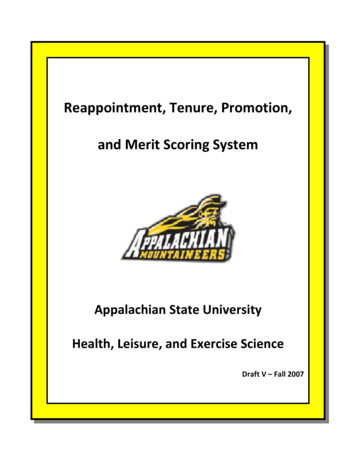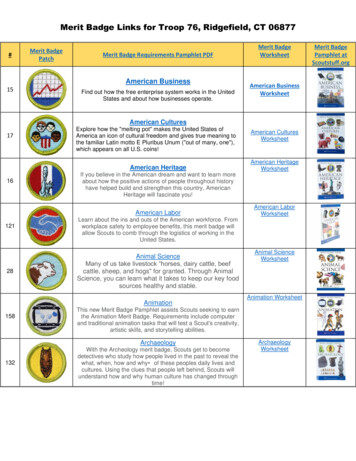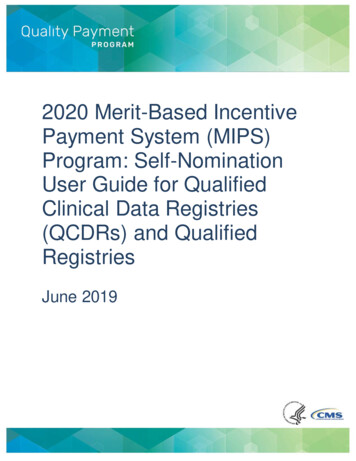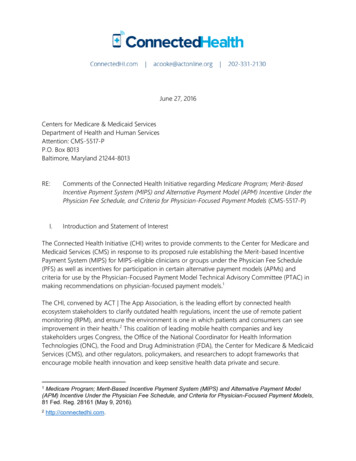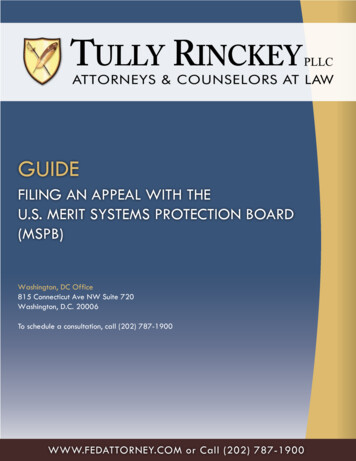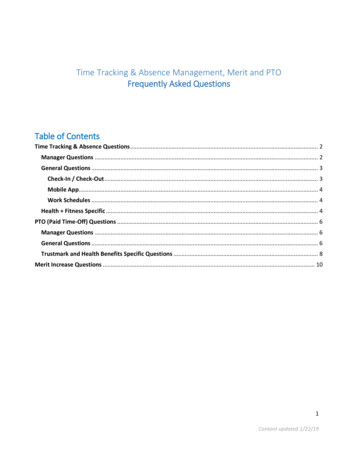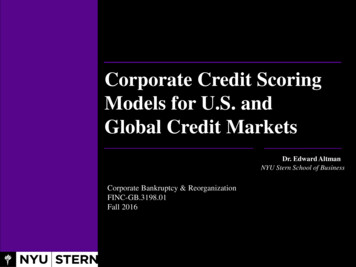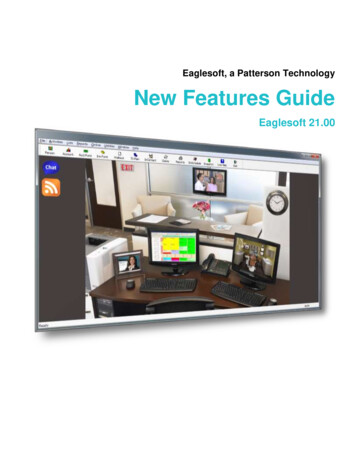
Transcription
Merit Credit Engine Features GuideThe Merit Credit Engine is a powerful credit report server softwareapplication that makes it possible for your Internet or in-house businesssystem to integrate credit data directly from Equifax, Experian, andTransUnion in the United States; Equifax and TransUnion in Canada.CBCInnovis and FirstAmerican are also supported for access to the U.S.credit repositories. English and French output is available in Canada.English and Spanish output is available for the U.S. and Puerto Rico.This document introduces you to the Merit Credit Engine (MCE), what youcan do with it, and how it and its development tools can be implementedfor credit bureau access. Credit Engine OverviewInternet and Intranet ApplicationsData FlowMCE Control FunctionsAbout the BureausConnectivity OptionsBureau Data Record LayoutsBusiness Credit ReportsXML Credit ReportsThree Bureau Merged ReportsProducts SupportedAbout Merit Credit SystemsConfiguration Options / System RequirementsClient ListMerit Credit Systems(800) 717-5170Specifications subject to change without notice.http://www.creditengine.net
Merit Credit Engine Features GuideCredit Engine OverviewThe Merit Credit Engine is software that works as a background Windowsservice, processing requests for credit reports. With the MCE, no entity standsbetween you and the credit bureaus. All hardware and software is on yourpremises and under your control.The MCE uses SQL database technology, meaning that, inaddition to (or instead of) traditional “print image” creditreports, you can do inquiries to retrieve, analyze, and act uponspecific data elements.As a system integrator, you can map inquiries and results toyour own user interface. As an in-house developer, you can implement customcredit scoring and routing with the raw bureau data and you can store credit datain a way that makes it possible to analyze and refine scoringalgorithms in the future. As an information technologymanager, you can centralize credit retrieval and decisionfunctions, and ensure that only users with permissible purposehave access to needed reports.The Merit Credit Engine gets credit data directly from thenation’s three credit repositories: Experian, Equifax, andTransUnion, using your account(s) with the bureau(s). There are no transactionfees for use of the credit engine. The pricing per report is simplythe price that the repositories charge you.At a glance. Credit reports, scores, and other credit data.Software for Windows 2000, XP, or 2003Acts as a background service on 2000, XP, or 2003Integrates with your user interface.Microsoft SQL Server or IBM DB2XML credit report and Merged XML optionsInternet, Dialup, or Leased Line TCP socket to Equifax, Experian, andTransUnion.Compliant with credit bureau Internet security protocolsYour account is with the Equifax, Experian, and/or TransUnion creditrepositories (Optionally, CBCInnovis and/or FirstAmerican.)No "middleman" per-report transaction charges.For system integrators with or without ODBC and SQL skills.By Merit Credit Systems, the leading provider of bureau-certified system tosystem credit bureau interface software.Merit Credit Systems(800) 717-5170Specifications subject to change without notice.http://www.creditengine.net
Merit Credit Engine Features GuideInternet and intranet applicationsCredit reports have long been a separate step in the approval process. Standalone TTY credit terminals provided cryptic reports that had to be analyzed byexperienced credit managers. Windows desktop softwareapplications, and Internet access to credit reports have done littleto make the reports easier to use. The process has remainedlargely separate from other business and financial applications,requiring rekeying of input, and manual analysis of the output.With the Merit Credit Engine, credit decisions can become a builtin part of your system. The MCE provides developers the toolsneeded to retrieve credit data, store it, analyze it, and report it.Common applications for this technology include: Online approvalsCall-center instant decisionsCustom scoring, application routingIdentity and background verificationPoint-of-sale cross-selling opportunitiesVertical market software integration.Rendering of credit reports.Integration with existing databasesCredit report data, when stored in database tables, can be used to generate ascore, and provide historical data for developing custom scoring models. In fact,software is available to build, train and test custom credit scoring neuralnetworks.Lenders are major beneficiaries of the Merit Credit Engine technology, as itallows for custom integration into complex systems. Web-enabled Internet andintranet applications which combine sophisticated routing, data transformations,communication with funding sources, and loan processing software are allpossible because of the credit engine's ability to handle credit reports, as well asthe individual data elements within the reports.Merit Credit Systems(800) 717-5170Specifications subject to change without notice.http://www.creditengine.net
Merit Credit Engine Features GuideData FlowThe Merit Credit Engine provides direct credit bureau access to the three nationalcredit repositories, Experian, Equifax, and TransUnion. Because it uses yourbureau memberships, and your computer system, there are no middlemantransaction costs added to each report. There is no delay associated with runningrequests through a third party, and you can be confident the data is up to date,reflecting the file as it exists, the moment you request it.In most implementations, the process begins simply by inserting an inquiryrecord into the database Inquiries table. The credit engine senses the newinquiry and retrieves the credit report. Upon receipt, the raw data can be storedfor later processing, or it can be parsed immediately. (The parsed data resides intables. The public records table, for example, allows you to examine all publicrecords for each inquiry.) Human readable credit reports and/or XML data can begenerated and stored, or outputted immediately.Merit Credit Systems(800) 717-5170Specifications subject to change without notice.http://www.creditengine.net
Merit Credit Engine Features GuideMCE Control FunctionsMost interaction with the Merit Credit Engine is through software and datainterfaces, but a control panel is provided for server setup.Server module allows configuration, logging, diagnostics, andadministrative controlThe Server Module runs as an 2000, XP and 2003 service or Windowsapplication. It allows configuration of shared or separate transport lines forEquifax, Experian, and TransUnion, extensive trace and logging options, anddatabase connectivity.Import FunctionThe import monitor function provides an optional simple, yet flexible, alternativeto ODBC and SQL submission of inquiries. The Import Monitor can be configuredto watch specific directories for incoming requests. Once processed, inquiriescan be archived in a separate folder.The data provided by your application, and the organization of incoming requestsis fully configurable. You can specify data items to be ignored, and the order inwhich your inquiry appears. Inquiry files can contain single or multiple requests,for single or multiple bureaus.Export FunctionThe export monitor function provides an optional simple, yet flexible, alternativeto ODBC and SQL for access to response data from the bureaus. Humanreadable credit reports can be rendered and outputted to the file system,summary data can be generated, and/or custom files layouts can be exportedautomatically, with capabilities to launch external processes upon arrival of reportdata.Merit Credit Systems(800) 717-5170Specifications subject to change without notice.http://www.creditengine.net
Merit Credit Engine Features GuideAbout the BureausThe three national credit bureaus are competing companies.They gather their consumer data separately, and don't share itamong themselves.Though formatted differently, consumer credit reports from thethree bureaus all show current and former addresses,employers, recent inquiries by credit grantors, fraud alerts, andpublic records. The tradelines section includes credit limits,balances owing, and payment histories for loans, credit cards,and other accounts, as reported by subscribers to the particularcredit repository - whether Experian, Equifax, or TransUnion.Financial institutions often request FICO, Beacon, or Empiricacredit score as part of the report. The score is a statisticallyproven weighting of items in the report, boiling it down to asingle a number to simplify decisions about credit-worthiness orthe likelihood of bankruptcy. Codes and descriptions indicatingthe reasons for the score are also included.Because the bureaus don't share data, it is common to finddifferences in the data, as well as the scores, for the sameconsumer. Many companies are members of just one or two ofthe bureaus, but not all three. Not all companies report to thebureaus. Some companies only report derogatory data.Connectivity optionsConnectivity to Equifax, Experian, and or TransUnion is a practical issue indeveloping a system utilizing credit report data. The considerations are speed,cost, security, and availability. Fortunately, the Merit Credit Engine covers all thebases.In most installations, the Internet provides device connectivityusing HTTPS. Standard Windows 32-bit TAPI handlers may beused where non-Internet connections are needed.Protocol connectivity - the proprietary bureau protocols andTCP/IP - are handled transparently by the credit engine, with support for multithreaded simultaneous access to all three bureaus.Merit Credit Systems(800) 717-5170Specifications subject to change without notice.http://www.creditengine.net
Merit Credit Engine Features GuideInternet AccessExperian, Equifax, and TransUnion each have protocols for creditbureau Internet security, and the Merit Credit Engine supportsthem all. Always-on connection to bureau data.Uses Secure SocketsCompatible with common infrastructure.Highly Cost-effectiveNote that the Internet connections used by the Merit Credit Engine are separatefrom those used for browser access to Internet credit portals. Thus, they arequick, and can be integrated into custom systems without requiring the use of abrowser.Data circuit Always-on connection to bureau data.Avoids Internet security issues.Modem* Where available, local and toll-free modems may be used to access creditbureau data.The Merit Credit Engine centralizes modem access and handles queuesso that each workstation does not need to have a modem.After call establishment, data retrieval speeds compare favorably all othermethods of data access.MCE software can be configured to maintain the connection betweenrequests during periods of high activity.The three bureaus can be handled with the same modem, separatededicated modems, or shared modem pools.Avoids Internet security issues.*Note: several of the bureaus have eliminated modems as a means of connectionMerit Credit Systems(800) 717-5170Specifications subject to change without notice.http://www.creditengine.net
Merit Credit Engine Features GuideBureau Data Record LayoutsThe Merit Credit Engine gives your application a well-defined, useable internaldata interface. It avoids error-prone text parsing. All three bureaus can sendtheir data in two ways: Text and System-to-System.Text Credit ReportsCredit bureaus can format reports and send them to you as text. This is the TTYmethod. It is used by the standalone "teletype" terminals that were oncecommon, and in low-cost desktop PC software packages, whichsimply request it, and print it verbatim.The TTY method provides human readable information, but it isnot suited to any application that needs to actually use the reportdata. A program would need to parse the data to find the specificdata elements, and could easily be "broken" with any minor layoutchange from the bureau, any unexpected message on the report, or any glitch inthe data stream. The bureaus specifically warn against trying to parse textreports. They don't publish technical specifications for them, and they reserve theright to make layout changes without warning.System to System Credit ReportsThe faster and more powerful alternative is to request bureaudata in a system-to-system format. Data arrives in packed,predefined record layouts. It is near-impossible for human eyesto read, but the computer can handle it quite well. To gethuman-readable reports, the program "renders" them locally, ina layout and font that may be completely custom, or in a stylethat replicates the TTY style of the originating bureau.A major benefit of system-to-system is that the individual detailed data elementsof a credit report can be used reliably in custom systems.As the bureaus add new data elements, they do so with strict version control, andin a way that protects the integrity of existing systems. For example, when thebureaus went to 4-digit years, they did so by adding data segments to handlethem. Applications that didn't need the 4 digits could count on the 2-digit yearfields remaining where they had always been.Merit Credit Systems(800) 717-5170Specifications subject to change without notice.http://www.creditengine.net
Merit Credit Engine Features GuideCan you do it yourself?To build an application using system-to-system data fromscratch, you have a lot of work on your hands.Fixed length record layouts are incompatible. Thebureaus all have different protocols. They don't use thesame terminology. Their reports are formatted differently.Reporting periods differ. Error and reason codes differ,and they are often quite cryptic.After obtaining the hundreds of pages of bureau documentation, you'll soonrealize that you have over 1800 different data elements to deal with.When you are ready for testing, how do you test your system when the FairCredit Reporting act makes it a Federal offense to use live data from realconsumers? Testing is not a permissible purpose for retrieving credit data!Bureau documentation, though extensive, is subject to misinterpretation.Developers soon learn that test data does not always represent real-world dataaccurately. One reason is that credit records were originally amassed from localbureaus around the country, each of which had their own ways of representingdata. On occasion, you may find non-conforming data that can crash a"perfectly" designed system. It can take years of field operation and hundreds ofthousands of reports to run across these anomalies in the data.The Merit Credit Engine is the only practical, cost effective, and expeditious wayto implement a system using credit report data.The MCE. Uses system-to-system protocolsIs able to render HTML or text reports from the system to system dataResolves bureau incompatibilities to a single data interfaceHandles all connectivity, data transfer, and data storageUse standard SQL syntax and/or comma delimited filesProvides field-proven data handlingIs fully and clearly documented.Merit Credit Systems(800) 717-5170Specifications subject to change without notice.http://www.creditengine.net
Merit Credit Engine Features GuideXML credit reportsXML (Extensible Mark-up Language) is emerging as the way in which all kinds oftransaction data is passed from computer to computer, and the Merit CreditEngine has optional modules that support the latest open standards forrepresenting and handling credit report data with XML.For credit reports, the original XML specification is MISMO, provided by TheMortgage Banker's Association of America's Mortgage Industry StandardsMaintenance Organization. The overall XML mortgage specification covers loanorigination, real estate services, secondary marketing, and servicing. The MeritCredit Engine's XML option is able to provide data in the correct format for thoseparts of the standard related to credit reports: double or tri-merged (using theMCE merge option) as well as single-bureau.The XML credit report standards now make it possible for data files to besubmitted to Fannie Mae as well as Freddie Mac for an underwriting decision.HR-XML, from the HR-XML Consortium is also supported. HR-XML is the openstandard for data exchange in human resources applications, such asemployment background screening.Credit Bureau Data and XMLThe process of correctly converting data from the three bureaus to a commonformat, then representing it as an industry standard XML credit report issomething that the Merit Credit Engine is uniquely well qualified to perform. TheXML option addresses the issues of proper layout, standardized tag and attributenames, and standardized data representation. Hundreds of lookup tables areprocessed for each credit report in order to ensure that the data, and the wordingof each description conforms to the specifications. Merit Credit Systems(800) 717-5170Normalizes bureau data to standardizeddatabase tables.(Optionally) merges data.Converts to standard descriptions and wordingaccording to the Document Type Definition(DTD).Creates XML output.Specifications subject to change without notice.http://www.creditengine.net
Merit Credit Engine Features GuideThe Document Type Definition (DTD)The DTD, or Document Type Definition, is key to processing XML credit reportdata in a way that is compatible across an entire industry.Tools are available for transforming the XML credit report data to otherspecifications. XML has the advantage of being extensible, so that custom tagsto store other types of data can be added without breaking the original code.Within the MISMO specification, there is room for custom data, includingsummary representations of the credit report data, which the Merit Credit Engineis able to do, allowing for easier processing.XML credit report data can be handled manually, but the latest programmingtools can relieve developers of the details. The Microsoft .NET (dot net)framework is based on XML, and its data access API (known as ADO .NET)encapsulates classes for reading, writing and the navigating XML data. VisualBASIC, Visual C and other programming tools are beginning to simplify all ofthis, both for standalone, and for web-based applications.As they are quite comprehensive, the MISMO and HR-XML specifications forcredit reports are readily adaptable to applications other than mortgage andhuman resources.XML and DecisioningXML was conceived primarily as neutral self-describing way of transferring datafrom one party to another. Once it is at a particular destination, tools areavailable for importing XML to traditional database storage, or for handling theXML credit report data on a node-bynode basis.Here is a glimpse of some of the XMLcredit report data that might exist for aliability item. You see things such asAccount Identifier (the account number),open date, status date, creditor name,high credit amount, etc. A customdecision process can cycle through thisand other information to arrive at ascore or decision. This information canbe used in other ways, as well, such aspopulating part of a loan application.Merit Credit Systems(800) 717-5170Specifications subject to change without notice.http://www.creditengine.net
Merit Credit Engine Features GuideEquifax ProductSupport Credit Retrieval - System to System 5 and 6Credit Reports - TTY (DAT)Joint Credit ReportsDTEC (SSN searches)Persona (Pre-Employment Report)FindersID ReportOnline DirectoryDASBeacon and all Equifax Risk ModelsInternet STS (ISTS) Version 5 and 6 Equifax (U.S.) Equifax of Canada (Direct access to CanadianConsumer and Business Credit Reports with Englishor French output)Equifax North American Link (U.S. / Canadianaccess.)Other Equifax products and features may be available. Please ask.Merit Credit Systems(800) 717-5170Specifications subject to change without notice.http://www.creditengine.net
Merit Credit Engine Features Guide
Text Credit Reports Credit bureaus can format reports and send them to you as text. This is the TTY method. It is used by the standalone "teletype" terminals that were once common, and in low-cost desktop PC software packages, which simply request it, and print it verbatim. The
